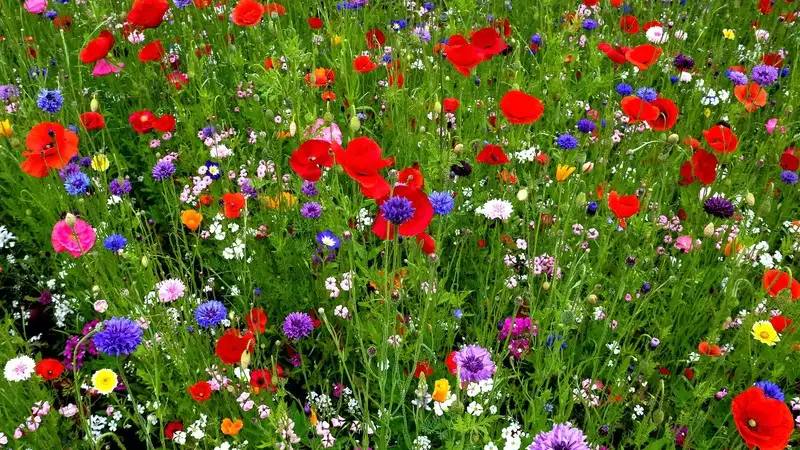While disadvantages of wildflower meadows add natural beauty and support biodiversity, they come with some notable downsides that are often overlooked. In the UK, over 97% of traditional wildflower meadows have disappeared since the 1930s. Meanwhile, insect populations, which rely on these habitats, have declined by 60% in the past 20 years. Additionally, nearly 30% of native wildflower species are now endangered, and pollinators like bees are facing extinction risks, with 17 bee species already lost from the region. These declines highlight the importance of creating meadow spaces, despite the various challenges.
Here, we explore Disadvantages of Wildflower Meadows to help you make an informed decision.
Initial Challenges in Establishing a Wildflower Meadow
Creating a wildflower meadow is far more complex than simply scattering seeds. One of the primary hurdles is soil preparation. Wildflowers typically thrive in nutrient-poor soils, so before planting, it’s necessary to reduce soil fertility, which may involve halting fertilizers or even stripping away the topsoil. For some homeowners, this can be a labor-intensive process, and if not done correctly, it could hinder the growth of the meadow.
Selecting the right seed mix is another crucial step. Wildflower species vary in terms of their soil and climate preferences, so a poorly chosen mix can result in a patchy meadow or plants that struggle to survive. This selection process requires research and an understanding of local soil conditions, which may be time-consuming.
Additionally, wildflower meadows do not reach their peak beauty instantly. Unlike traditional lawns, which can be seeded and become green within a short time, wildflower meadows may take two to three years to establish fully. During this period, the meadow may appear uneven or sparse, requiring patience from the gardener and an understanding that results will not be immediate.
Maintenance and Upkeep Requirements
While often marketed as “low-maintenance,” wildflower meadows require specific upkeep to maintain their health and appearance. One of the biggest challenges is weed control. Invasive weeds can quickly overtake a wildflower meadow, outcompeting the native flowers and grasses for nutrients and sunlight. Managing these weeds often involves careful hand weeding, which is more labor-intensive than the straightforward mowing associated with traditional lawns.
Wildflower meadows also require a specific mowing schedule to maintain a balance between flowers and grasses. Generally, meadows are mowed once or twice a year, typically in late summer or early fall, to mimic the natural cycles of hay meadows. This seasonal mowing prevents woody plants from taking over, but it requires knowledge of timing and techniques to avoid damaging the wildflowers.
In addition to weed and grass management, pest control can also be a concern. While wildflower meadows attract beneficial insects, they can also draw unwanted pests, like rodents or certain insect species, that may be detrimental to nearby gardens or crops. For homeowners who prefer a pest-free yard, this can be a drawback that demands additional control measures.
Aesthetic Considerations
One common drawback of wildflower meadows is their natural, untamed appearance, which may not appeal to everyone. Unlike manicured lawns that provide a neat, uniform look, wildflower meadows change dramatically with the seasons. By late summer, for instance, they may start to look overgrown or brown as flowers go to seed, giving a less polished appearance.
The blooming patterns of wildflowers are also inconsistent, with different species flowering at varying times throughout the year. This can lead to a sporadic look, with blooms peaking in some areas while others appear sparse or even bare. While this natural variability is part of a meadow’s charm, it may not satisfy those who prefer a steady and predictable aesthetic.
Unsuitability for High Foot Traffic
Traditional lawns are popular partly because they can withstand frequent foot traffic, making them ideal for family activities or pet play areas. In contrast, wildflower meadows don’t suit heavy use. People can easily trample the fragile flowers and grasses, making these meadows less suitable for spaces with frequent activity.
For families with children or pets, the uneven ground and taller grasses of a wildflower meadow can present challenges. Running or walking through a meadow is more challenging than on a flat lawn, and the risk of damaging plants is higher. Consequently, lower-traffic areas or homeowners seeking aesthetic beauty over practicality may be better suited for wildflower meadows.
Potential Wildlife Concerns
While wildflower meadows are excellent habitats for a range of species, they can also attract unwanted wildlife, which can be a concern for some homeowners. Small animals, such as rodents, are naturally drawn to the cover provided by a meadow, potentially making them an issue in residential areas. If your meadow is near a vegetable garden, these animals might even begin to forage on your crops.
Insects are another consideration. While many people welcome the presence of bees, butterflies, and beneficial insects, wildflower meadows can attract other bugs that are less desirable, such as beetles or even ticks. This influx of insects can be problematic for those with sensitivities or allergies, especially in peak bloom seasons when pollen levels are high.
Fire Hazard in Dry Regions
In areas prone to drought or dry summers, wildflower meadows can pose a fire risk due to the accumulation of dry plant material. By late summer, the meadow’s vegetation can become dry and brittle, increasing the likelihood of a fire hazard. Homeowners in fire-prone regions must take extra care to clear away dry plant material and reduce potential risks, which can be a time-consuming process.
Managing the build-up of dead vegetation typically involves clearing away cuttings after seasonal mowing. While this step is important for reducing fire risk, it also adds to the maintenance requirements, which may not appeal to those seeking a truly hands-off landscape option.
Limited Winter Appeal
During winter, wildflower meadows generally lose their visual appeal and can appear barren or unkempt. Unlike lawns or evergreen plants that maintain their greenery throughout the year, meadows turn brown and sparse, with only a few stems remaining.
For those who value year-round visual interest, the bare appearance of a wildflower meadow in winter may be disappointing. Meadows typically lack the structure provided by evergreen shrubs or perennial borders, resulting in a less attractive landscape during the colder months. Homeowners should consider whether they’re willing to trade off winter appeal for the seasonal beauty of a meadow.
Long-Term Soil Impact and Difficulty in Reverting
Establishing a wildflower meadow can have lasting effects on soil composition, which can make it difficult to revert to a traditional lawn or other landscaping choices if preferences change in the future. Over time, wildflower meadows alter the soil to be more compatible with native plants and nutrient-poor conditions, which may not support other types of plants or crops.
Reverting a meadow back to a lawn or garden often involves significant effort, including soil remediation to reintroduce nutrients and remove residual wildflower seeds. For homeowners who anticipate changing their landscape design, this is a drawback that can add both time and cost to a future conversion.
Final Thoughts
Disadvantages of Wildflower Meadows are an eco-friendly, beautiful alternative to traditional lawns that support pollinators, reduce maintenance, and foster biodiversity. However, they come with challenges that may not suit every environment or aesthetic preference. From initial setup and ongoing weed management to fire risks and limited winter appeal, the disadvantages of wildflower meadows highlight that these landscapes are best suited for gardeners who have a clear understanding of their unique requirements. With careful planning and consideration of the potential drawbacks, a wildflower meadow can be a rewarding addition to a property, offering both ecological value and natural beauty.

